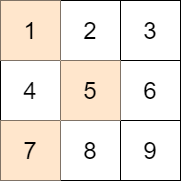- {x}
- Count Nodes Equal to Sum of Descendants
- Minimum Time to Type Word Using Special Typewriter
- Maximum Matrix Sum
- Number of Ways to Arrive at Destination
- Number of Ways to Separate Numbers
- Employees Whose Manager Left the Company
- Find Greatest Common Divisor of Array
- Find Unique Binary String
- Minimize the Difference Between Target and Chosen Elements
- Find Array Given Subset Sums
- Widest Pair of Indices With Equal Range Sum
- Minimum Difference Between Highest and Lowest of K Scores
- Find the Kth Largest Integer in the Array
- Minimum Number of Work Sessions to Finish the Tasks
- Number of Unique Good Subsequences
- Find Cutoff Score for Each School
- Maximum Number of People That Can Be Caught in Tag
- Read More...

Minimize the Difference Between Target and Chosen Elements
You are given an m x n integer matrix mat and an integer target.
Choose one integer from each row in the matrix such that the absolute difference between target and the sum of the chosen elements is minimized.
Return the minimum absolute difference.
The absolute difference between two numbers a and b is the absolute value of a - b.
Example 1:

Input: mat = [[1,2,3],[4,5,6],[7,8,9]], target = 13 Output: 0 Explanation: One possible choice is to: - Choose 1 from the first row. - Choose 5 from the second row. - Choose 7 from the third row. The sum of the chosen elements is 13, which equals the target, so the absolute difference is 0.
Example 2:

Input: mat = [[1],[2],[3]], target = 100 Output: 94 Explanation: The best possible choice is to: - Choose 1 from the first row. - Choose 2 from the second row. - Choose 3 from the third row. The sum of the chosen elements is 6, and the absolute difference is 94.
Example 3:

Input: mat = [[1,2,9,8,7]], target = 6 Output: 1 Explanation: The best choice is to choose 7 from the first row. The absolute difference is 1.
Constraints:
m == mat.lengthn == mat[i].length1 <= m, n <= 701 <= mat[i][j] <= 701 <= target <= 800
Solution Explanation: Minimizing Difference Between Target and Chosen Elements
This problem asks to find the minimum absolute difference between a target value and the sum of elements chosen from each row of a matrix. A dynamic programming approach proves efficient, leveraging the concept of a grouped knapsack problem.
Approach: Dynamic Programming (Bitmask Optimization)
The core idea is to iteratively build a set of all possible sums achievable by selecting one element from each row. We then find the sum within this set that's closest to the target.
-
Initialization: Start with a set containing only 0 (representing the sum before choosing any elements).
-
Iteration: For each row in the matrix:
- Create a new set.
- For each existing sum (
s) and each element (x) in the current row:- Add (
s + x) to the new set. This represents the new sum after includingxfrom this row.
- Add (
- Replace the existing set with the new set.
-
Finding Minimum Difference: Iterate through the final set of sums, calculating the absolute difference between each sum and the
target. Return the minimum difference found.
Time and Space Complexity Analysis:
-
Time Complexity: O(m * n * S), where 'm' is the number of rows, 'n' is the number of columns, and 'S' is the maximum possible sum of elements (approximately m * max(mat[i][j])). In the worst case, the size of the set of possible sums grows exponentially with the number of rows. However, the constraints of the problem (m, n <= 70, mat[i][j] <=70) keep the problem computationally manageable.
-
Space Complexity: O(S), where 'S' is again the maximum possible sum of elements. The space is dominated by the set containing possible sums.
Code Implementation (Python)
This code uses sets for efficient management of possible sums, avoiding duplicate values.
class Solution:
def minimizeTheDifference(self, mat: List[List[int]], target: int) -> int:
sums = {0} # Initialize with sum 0
for row in mat:
new_sums = set()
for s in sums:
for x in row:
new_sums.add(s + x)
sums = new_sums # Update sums for the next iteration
min_diff = float('inf') # Initialize with a large value
for s in sums:
min_diff = min(min_diff, abs(s - target))
return min_diff
Code Implementation (Java)
Java's HashSet provides similar functionality to Python's set.
import java.util.*;
class Solution {
public int minimizeTheDifference(int[][] mat, int target) {
Set<Integer> sums = new HashSet<>();
sums.add(0);
for (int[] row : mat) {
Set<Integer> newSums = new HashSet<>();
for (int s : sums) {
for (int x : row) {
newSums.add(s + x);
}
}
sums = newSums;
}
int minDiff = Integer.MAX_VALUE;
for (int s : sums) {
minDiff = Math.min(minDiff, Math.abs(s - target));
}
return minDiff;
}
}The C++ and Go implementations would follow a similar structure, using their respective set data structures (e.g., std::unordered_set in C++ and map[int]bool in Go, where the bool acts as a flag to mark the presence of a sum). The fundamental algorithmic approach remains the same.